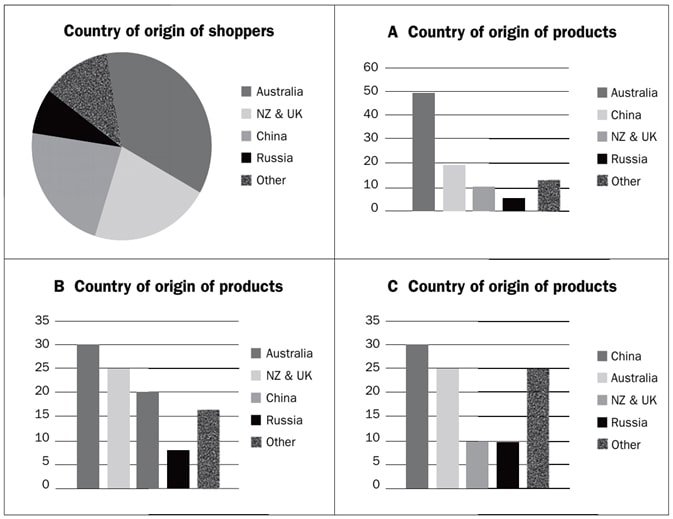Table of Contents
BEST IELTS Academic Reading Test 75
ACADEMIC READING TEST 75 – PASSAGE – 2

ACADEMIC READING TEST – 75
READING PASSAGE – 2
You should spend about 20 minutes on Questions 14-26 which are based on Reading Passage 2 below.
BRAND LOYALTY RUNS DEEP
At almost any supermarket in Sydney, Australia, food from all over the world fills the shelves. Perhaps you fancy some Tick Tock Rooibos tea made in South Africa, or some Maharaja’s Choice Rogan Josh sauce from India. Alongside local Foster’s beer, Chinese Tsingtao and Indonesian Bintang are both to be found. For homesick Britons, the confectionary aisle is stocked with Mars Bars and Bountys, while for pining Poles sweets manufactured by firms like Wawel or Solidarposc are available. Restaurants in Sydney range from Afghan to Zambian, catering for different ethnic groups as well as the rest of the curious general public.
All of this variety is a result of population movement and changes in global trade, and, to a lesser extent, reduced production and transportation costs. While Australia can claim around 40% of its population as the first generation, other countries, like Switzerland, may have fewer international migrants, but still, have people who move from city to city in search of work. Even since the 1990s, taxes or tariffs on imported goods have decreased dramatically. The World Trade Organisation, for example, has promulgated the idea of zero tariffs, which has been adopted into legislation by many member states. It is estimated that within a century, agriculture worldwide has increased its efficiency five-fold. Faster and better-integrated road and rail services, containerisation, and the ubiquitous aeroplane have sped up transport immeasurably.
Even with this rise in the availability of non-local products, recent studies suggest that supermarkets should do more to increase their number to match more closely the proportion of shoppers from those countries or regions. Thus, if 10% of a supermarket’s customers originate in Vietnam, there ought to be 10% Vietnamese products in store. If Americans from southern states dominate in one northern neighbourhood, southern brands should also be conspicuous. Admittedly, there are already specialist shops that cater to minority groups, but minorities do frequent supermarkets.
Two separate studies by Americans Bart Bronnenberg and David Atkin have found that brand loyalty (choosing Maharaja’s Choice over Patak’s, or Cadbury’s over Nestlé) is not only determined by advertising, but also by a consumer’s past. If a product featured in a person’s early life in one place, then, as a migrant, he or she is likely to buy that same product even though it is more expensive than an otherwise identical locally-produced one.
In the US context, between 2006 and 2008, Bronnenberg analysed data from 38,000 families who had bought 238 different kinds of packaged goods. Although the same brands could be found across America, there were clear differences in what people purchased. In general, there were two leading brands in each kind of packaged good, but there were smaller brands that assumed a greater proportion of consumers’ purchases than was statistically likely. One explanation for this is that 16% of people surveyed came from interstate, and these people preferred products from their home states. Over time, they did buy more products from their adopted state, but, surprisingly, it took two decades for their brand loyalty to halve. Even people who had moved interstate 50 years previously maintained a preference for home-state brands. It seems the habits of food buying change more slowly than we think.
Bronnenberg’s findings were confirmed by Atkin’s in India although there was something more unexpected that Atkin discovered. Firstly, during the period of his survey, the cost of all consumables rose considerably in India. As a result, families reduced their spending on food, and their calorific intake fell accordingly. It is also worth noting that although India is one country, states impose tariffs or taxes on products from other Indian states, ensuring that locally-produced goods remain cheaper. As in the US, internal migrants bought food from their native place even when it was considerably more expensive than local alternatives, and at a time when you might expect families to be economising. This element made the brand-loyalty theory even more convincing.
There is one downside to these findings. In relatively closed economies, such as India’s, people develop tastes that they take with them wherever they go; in a more globalised economy, such as America’s, what people eat may be more varied, but still dependent on early exposure to brands. Therefore, according to both researchers, more advertising may now be directed at minors since brand loyalty is established in childhood and lasts a lifetime. In a media-driven world where children are already bombarded with information, their parents may not consider appropriate yet more advertising is hardly welcome.
For supermarkets, this means that wherever there are large communities of expatriates or immigrants, it is essential to calculate the demographics carefully in order to supply those shoppers with their favourite brands as in light of Atkin and Bronnenberg’s research, advertising and price are not the sole motivating factors for purchase as was previously thought.

Questions 14 – 18
Choose the correct letter: A, B, C, or D.
Write the correct letter in boxes 14-18 on your answer sheet.
14. In this article, the writer refers to food products that are sold
A. at markets.
B. wholesale.
C. online.
D. retail.
15. In Sydney, shoppers can buy beer from
A. China and Indonesia.
B. India and South Africa.
C. Poland.
D. Vietnam.
16. The greater variety of goods and brands now available is mainly due to:
A. cheaper production and more migration.
B. changes in migration and international trade.
C. cheaper production and transport.
D. changes in migration and transport.
17. The writer thinks supermarkets ………… should change their products slightly.
A. in Australia
B. in India and the US
C. in Switzerland
D. worldwide
18. The writer suggests that:
A. the quality of products at specialist shops will always be better than at supermarkets.
B. specialist shops will close down because supermarkets will be cheaper.
C. specialist shops already supply minority groups, so supermarkets shouldn’t bother.
D. specialist shops already supply minority groups, yet supermarkets should compete with them.
Question 19
Which chart below – A, B, or C – best describes the relationship between shoppers at one Sydney supermarket, and what research suggests that same supermarket should sell?
Write your answer in box 19 on your answer sheet.

Questions 20 – 26
Which study/studies do the following statements relate to?
In boxes 20-26 on your answer sheet, write:
A. if the information relates only to Atkin’s study
B. if the information relates only to Bronnenberg’s study
C. if the information relates to both Atkin’s and Bronnenberg’s studies
20. There was a correlation between brands a shopper used in childhood, and his or her preferences as an adult.
21. One reason for the popularity of smaller brands was that many people surveyed came from another state where those brands were bigger.
22. Even living in a new state for a very long time did not mean that shoppers chose new brands.
23. In general, food became more expensive during the time of the study. Despite this, families bought favourite brands and ate less.
24. Taxes on products from other states also increased the cost of food. This did not stop migrants from buying what they were used to.
25 Children may be the target of more food advertising now.
26 Advertising and price were once thought to be the main reasons for buying products. This theory has been modified now.
ANSWERS ARE BELOW
ANSWERS
14. D
15. A
16. B
17. D
18. D
19. B
20. C
21. C
22. B
23. A
24. A
25. C
26. C

